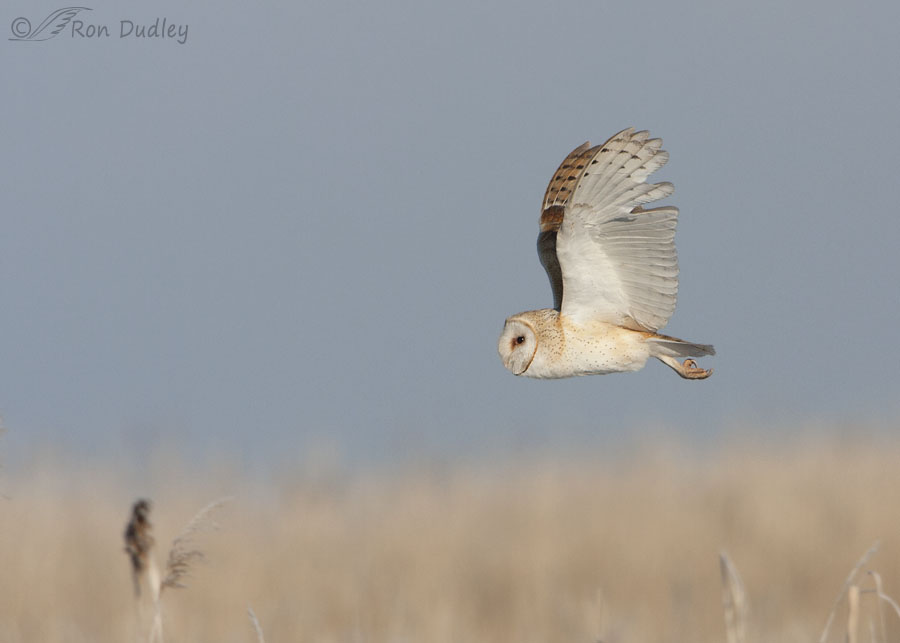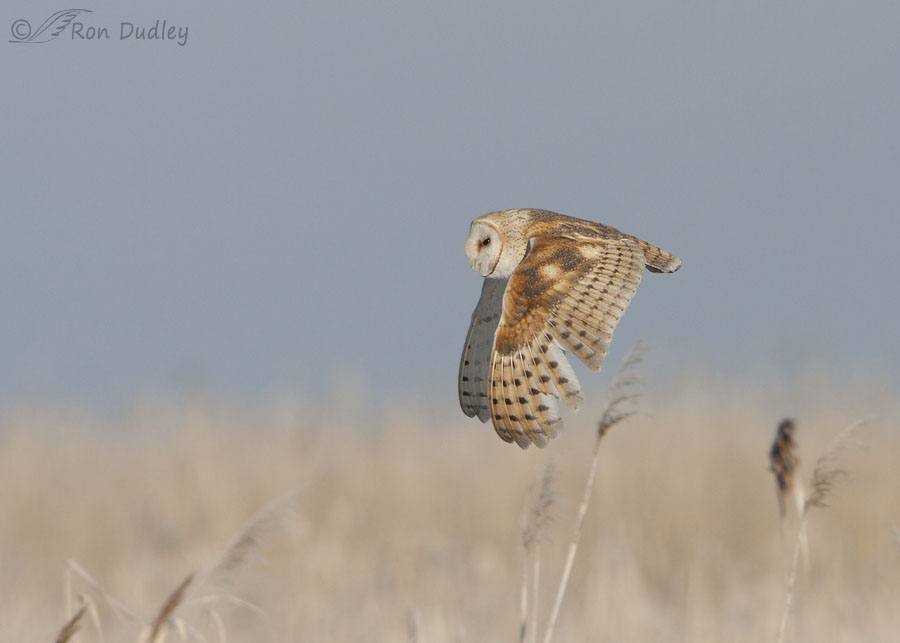Not my best Barn Owl flight shots but for me some of my most exciting.
For the first year or so after I purchased my first 500 f/4 lens I simply stopped even attempting to photograph birds in flight because on those few occasions when I tried I had virtually no success. Flight shots are hard and I had no skills. But the winter of 2007-8 was an unusually cold one so Barn Owls were hunting in daylight which gave me motivation to learn.
So that winter I spent endless early morning hours, often at Farmington Bay WMA, freezing my butt off as I stood in snow in front of my tripod and waited for Barn Owls to appear. Early on I had very few successes. Hell, I didn’t even know what camera settings to use for birds in flight and I’m not kidding. On those rare occasions when I was lucky enough to get an owl in my viewfinder the bird was usually soft, or over or underexposed, or had body parts clipped or cut off. I took more “air shots” than I care to remember.
But eventually I had a few successes and I was immediately addicted to flight shots. Especially of Barn Owls but of any birds, really.

1/2000, f/8, ISO 400, Canon 40D, Canon EF 500mm f/4L IS USM + EF 1.4 Extender, not baited, set up or called in
This series of two consecutive Barn Owl flight shots taken at Farmington on the morning of February 18, 2008 was one of my earliest successes. The owl suddenly appeared in front of a stand of phrags as it was hunting for voles. Back then I had great difficulty even finding a bird in flight in my viewfinder because learning to ‘aim’ a long lens quickly and accurately is tricky. And the longer the lens the trickier it gets so my 500mm lens was more than I could handle, at least at first.
But this owl wasn’t very close so I had time to find ‘him’ in my viewfinder and actually lock focus on him. The molting owl isn’t very large in the frame but he’s sharp and I like his wing position.
Back then I was shooting with my Canon 40D which had a burst rate of only 6 frames per second. Comparing the position in the frame of the dark phrag head at lower left in this shot to…

1/2000, f/8, ISO 400, Canon 40D, Canon EF 500mm f/4L IS USM + EF 1.4 Extender, not baited, set up or called in
its position in the next shot in the burst gives me a visual representation of how slow my burst rate was back then. My current camera, a 7D Mark II, has a burst rate of 10 frames per second so if I’d taken this series with my 7DII the owl would have only traveled a little over half as far between shots. And these days my 7DII is considered to be relatively slow.
I hope my readers don’t mind me reminiscing about the ‘old days’ like this. In the nine days since I got my lens back from the repair shop I’ve only been out photographing birds twice, mostly due to inclement weather, so I haven’t been able to get many new photos to post.
Hopefully my recent miserable track record is about to improve.
Ron


I don’t mind the older photos. I learned a lot from your blog by looking at your settings and by what you post about your experiences photographing. I still have trouble with tracking birds in flight and my lens is what you call your baby lens!
Thank you, April. Everyone has trouble tracking birds in flight, it’s just a matter of how much trouble.
I do hope you can get out of your cabin soon, but appreciate travelling down memory lane with you.
Thanks, EC. I finally got out this morning. Sure wish I’d found some birds…
Trying to get any object smaller than the sky in my field of view (not to mention focusing) with my digiscope setup leaves me to rely on you and your hard-earned skills.I appreciate it your sharing them.
Lyle, digiscoping certainly has it’s place but I can’t imagine using it for birds in flight.
Reminisce away, professor! You’ve always got new insights. At least they are new to me. With my memory, everything is…
Reminisce away…
Lol
Made me smile, Arwen. Made me smile…
Really enjoy the history behind the skills that you have today. Even with a non DSLR camera it has taken me quite a few years to master in flight or take off shots. I can only imagine how hard with a large long lens camera.
Thanks, Everett. You’re right, long focal lengths make most everything more difficult but they sure give nice, detailed results when you succeed.
I, for one, am very glad to read about just what kind of grit it took for you to
persevere in those early days to master your craft ( YES, YOU HAVE ! )
I’m just so glad for you that it paid off the way it has–it’s a rare character
trait, and it’s a fine thing to be reminded of it……and speaking of “grit”, I’ll
bet you grit your teeth when viewers coo about your “talent”–which you have,
for sure, but it’s only about 25% of the successful equation, in my book.
Much appreciated, Kris. I don’t think one ever “masters” photographing birds in flight but you can sure improve your odds drastically by having the right equipment, knowing how to use it and having the skill to do so. Knowing what to do is a lot different from being able to do it.
Throw in a stubborn streak (perseverance) and you’re well on your way.
Always happy to see barn owls!
YES. Any owls if the truth be told.
Good.
Glad you persevered AND are willing to share the challenges involved in acquiring the skills you have today! It’s easy to think having “the right equipment” will solve all problems….. Beautiful Barn Owl even if a bit “soft”.
Beautiful Barn Owl even if a bit “soft”.  They are such strange looking birds face wise.
They are such strange looking birds face wise.
Frame rate DOES make a difference. It’s VERY noticeable on my critter cam at times like when a stray cat that comes around all of a sudden has “something” up his ass at night to boot…
“It’s easy to think having “the right equipment” will solve all problems”
That’s what a lot of folks think, Judy. Then they spend the money and still have mostly mediocre photos. You need both, appropriate equipment for the situation and the knowledge and skill to use it to potential.
Beautiful photos Ron. I never mind the reminiscing. I always enjoy the photos and stories that go with them! I hope you have some good shooting weather soon!
Thanks very much, Mark. I’ve had cabin fever for days now.
Lovely shots, both, and with such soft, complementary light what’s not to like? And yes, I can relate to the difference a change from 3 fps to 10 makes; I know it has made me a much happier lady and I’m sure the same must be true for most.
Thanks, Granny Pat. For bird photography frame rate matters.